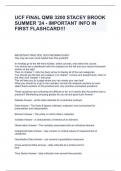Summary
Summary HEPATOPROTECTIVE ACTIVITY OF AQUEOUS EXTRACT OF CAESALPINIA BONDUC AGAINST CCL4 INDUCED CHRONIC HEPATOTOXICITY.
INTRODUCTION
The liver is a major target for the chemical induced toxicity, as it participates in the metabolism, detoxification, and secretory functions. Liver disease is a worldwide problem and in most of the cases, liver damage is due to oxidative stress. Liver damage if not managed at the ri...
[Show more]
Uploaded on
July 10, 2024
Number of pages
4
Written in
2023/2024
Type
Summary
Course
HEPATOPROTECTIVE ACTIVITY OF AQUEOUS.
All documents for this subject (1)
HEPATOPROTECTIVE ACTIVITY OF AQUEOUS EXTRACT OF





